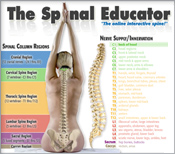| Disc Problems and the Chiropractic Lifestyle A disc doesn’t “slip”. Since spinal discs have a very poor blood supply, they also depend upon the circulation of joint fluids to bring in nutrients and expel waste. If a spinal joint loses its normal motion and this pumping action is impaired, the health of the disc deteriorates. Like a wet sponge, a healthy disc is flexible. A dry sponge is hard, stiff, and can crack easily. This is how many disc problems begin. Because of the way each disc is attached to the vertebra above and below it, a disc cannot “slip” as commonly thought. However, trauma or injury to the spine can cause discs to bulge, herniate, or worse, rupture. This can be quite painful, putting pressure on the spinal cord and nerve roots, often interfering with their function. The chiropractic approach to disc problems is to help restore better motion and position to the spinal joints. Besides reducing disc bulging, better spinal function helps decrease inflammation so the slow process of healing the surrounding soft tissues can begin. While results cannot be guaranteed, many patients have avoided needless surgery or a dependency on pain pills by choosing conservative chiropractic care. The traditional approach to disc problems often ignores spinal function. Conservative chiropractic care is safer and often more effective than back surgery. Because they are attached to vertebrae, discs do not slip, but they do tear, bulge, herniate, prolapse and dessicate. DISC TEAR The most common disc injury is a small crack or microtear in the tough, outer cartilage material of the disc called annular fibers. This allows the fluid to start leaking out, and the disc begins to wear thin. BULGING DISC The soft jelly-like material in the middle of the disc pushes to one side, forward or backward, and swelling occurs. The nucleus is still contained within the tough outer fibers of the disc, but can still cause pressure and painful symptoms. HERNIATED DISC The soft jelly-like material from the nucleus in the middle of the disc ruptures through the tough, outer fibers and extends to the outer edge or beyond the normal limits of the disc. PROLAPSED DISC A piece of disc material separates away and becomes a fragment or a free-floating piece. DESSICATED DISC The disc loses its fluid content and degenerates down to a rough, worn-down or worn-out appearance. This occurs as the bones begin to fuse to each other. The intervertebral disc. While the intervertebral disc is a common culprit in spine-related health problems, its function is widely misunderstood. The disc is a small cartilage pad that is situated between spinal bones. The soft jelly-like center is contained by layers of fibrous tissues. Each disc serves as a connector, spacer, and shock absorber for the spine. When healthy, discs allow normal turning and bending. Discs can bulge, herniate or rupture, resulting in other problems.
THE CHIROPRACTIC LIFESTYLE
Chiropractors are experts in the care of the bones, nerves, muscles and connective tissues that make up about 60% of your body. All of the joints in your body are part of this musculo-skeletal system and its optimal function is necessary for overall good health. Ask your Doctor of Chiropractic for more information about a care program that may include specific spinal adjustments, exercise recommendations, nutritional advice or other conservative methods of care based on your health history, age, current condition and lifestyle. REFERENCES:
Cassidy, J. D., Thiel, H. W., Kirkaldy-Willis, W. H., Side Posture Manipulation for Intervertebral Disc Herniation, Journal of Manipulative and Physiological Therapeutics, 16:97-103, 1993. Cotler, H., M. D., Goyer, L., M. D., Hochschuler, S., M. D., Rehabilitation of the Spine, Mosby, 1993. Cox, J., D. C., Low Back Pain, Mechanism, Diagnosis and Treatment, 4th edition, Williams and Wilkins, 1990. Cox, J., D. C., Hazen, R., Distraction Manipulation Reduction of an L5-S1 Disc Herniation, Journal of Manipulative and Physiological Therapeutics, 16:342-346, 1993. Hochschuler, S., M.D., Texas Back Institute, Back in Shape, Houghton Mifflin Company, 1991. Kapandji, I. A., The Physiology of the Joints, Vol. 3, Churchill Livingstone, 1982. Kellett, J., Acute Soft Tissue Injuries: A Review of the Literature, Medicine and Science of Sports and Exercise, Vol. 18, No. 5, p.489-500, American College of Sports Medicine, 1986. Kessler, R., Hertling, D., Management of Common Musculoskeletal Disorders, Harper and Row, 1983. Manelfe, C., M.D., Imaging of the Spine and Spinal Cord, Raven Press, 1992. Nwuga, VCB: Relative Therapeutic Efficacy of Vertebral Manipulation and Conventional Treatment in Back Pain Management, Am. Phys. Med., 61:273, 1982. Valenti, E., Acute Lumbar Disc Syndrome Under Chiropractic Care; A Two Year Statistical Study, Swiss Chiropractic Association, 51 Avenue Du Casino, Montreux, Switzerland, 1820, September, 1979. White, A. A., M.D. and Panjabi, M. M., Ph.D., Clinical Biomechanics of the Spine, 2nd edition, J. B. Lippincott, 1990. ©2002 Back Talk Systems, Inc. (800) 937-3113 (303) 277-9990 www.backtalksystems.com |
1750 West Broadway Street, Suite 108 | Oviedo, Florida 32765
Tel: (407) 977-7233 | Fax: (407) 359-6822
Office Hours - call for appointment times
Oviedo Florida Chiropractor Chiropractors Chiropractic Doctors
Copyright 2024 - ChiroPlanet.com
Privacy Notice - Admin

